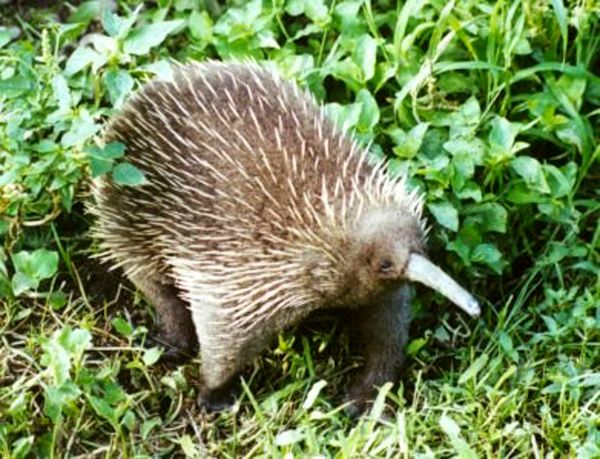Source: NYTimes
More at the link
Link to the abstract of the paper: http://www.sciencemag.org/content/339/6120/662.abstract

Humankinds common ancestor with other mammals may have been a roughly rat-size animal that weighed no more than a half a pound, had a long furry tail and lived on insects.
In a comprehensive six-year study of the mammalian family tree, scientists have identified and reconstructed what they say is the most likely common ancestor of the many species on the most abundant and diverse branch of that tree the branch of creatures that nourish their young in utero through a placenta. The work appears to support the view that in the global extinctions some 66 million years ago, all non-avian dinosaurs had to die for mammals to flourish.
Scientists had been searching for just such a common genealogical link and have found it in a lowly occupant of the fossil record, Protungulatum donnae, that until now has been so obscure that it lacks a colloquial nickname. But as researchers reported Thursday in the journal Science, the animal had several anatomical characteristics for live births that anticipated all placental mammals and led to some 5,400 living species, from shrews to elephants, bats to whales, cats to dogs and, not least, humans.
A team of researchers described the discovery as an important insight into the pattern and timing of early mammal life and a demonstration of the capabilities of a new system for handling copious amounts of fossil and genetic data in the service of evolutionary biology. The formidable new technology is expected to be widely applied in years ahead to similar investigations of plants, insects, fish and fowl.
Given some belated stature by an artists brush, the animal hardly looks the part of a progenitor of so many mammals (which do not include marsupials, like kangaroos and opossums, or monotremes, egg-laying mammals like the duck-billed platypus).
Maureen A. OLeary of Stony Brook University on Long Island, a leader of the project and the principal author of the journal report, wrote that a combination of genetic and anatomical data established that the ancestor emerged within 200,000 to 400,000 years after the great dying at the end of the Cretaceous period. At the time, the meek were rapidly inheriting the earth from hulking predators like T. rex.
Within another two million to three million years, Dr. OLeary said, the first members of modern placental orders appeared in such profusion that researchers have started to refer to the explosive model of mammalian evolution. The common ancestor itself appeared more than 36 million years later than had been estimated based on genetic data alone.
Although some small primitive mammals had lived in the shadow of the great Cretaceous reptiles, the scientists could not find evidence supporting an earlier hypothesis that up to 39 placental mammalian lineages survived to enter the post-extinction world. Only the stem lineage to Placentalia, they said, appeared to hang on through the catastrophe, generally associated with climate change after an asteroid crashed into Earth.
The research team drew on combined fossil evidence and genetic data encoded in DNA in evaluating the ancestors standing as an early placental mammal. Among characteristics associated with full-term live births, the Protungulatum species was found to have a two-horned uterus and a placenta in which the maternal blood came in close contact with the membranes surrounding the fetus, as in humans.
The ancestors younger age, the scientists said, ruled out the breakup of the supercontinent of Gondwana around 120 million years ago as a direct factor in the diversification of mammals, as has sometimes been speculated. Evidence of the common ancestor was found in North America, but the animal may have existed on other continents as well.
The publicly accessible database responsible for the findings is called MorphoBank, with advanced software for handling the largest compilation yet of data and images on mammals living and extinct. This has stretched our own expertise, Dr. OLeary, an anatomist, said in an interview.
The findings were not a total surprise, she said. But its an important discovery because it relies on lots of information from fossils and also molecular data. Other scientists, at least a thousand, some from other countries, are already signing up to use MorphoBank.
More at the link
Link to the abstract of the paper: http://www.sciencemag.org/content/339/6120/662.abstract
To discover interordinal relationships of living and fossil placental mammals and the time of origin of placentals relative to the Cretaceous-Paleogene (K-Pg) boundary, we scored 4541 phenomic characters de novo for 86 fossil and living species. Combining these data with molecular sequences, we obtained a phylogenetic tree that, when calibrated with fossils, shows that crown clade Placentalia and placental orders originated after the K-Pg boundary. Many nodes discovered using molecular data are upheld, but phenomic signals overturn molecular signals to show Sundatheria (Dermoptera + Scandentia) as the sister taxon of Primates, a close link between Proboscidea (elephants) and Sirenia (sea cows), and the monophyly of echolocating Chiroptera (bats). Our tree suggests that Placentalia first split into Xenarthra and Epitheria; extinct New World species are the oldest members of Afrotheria.





